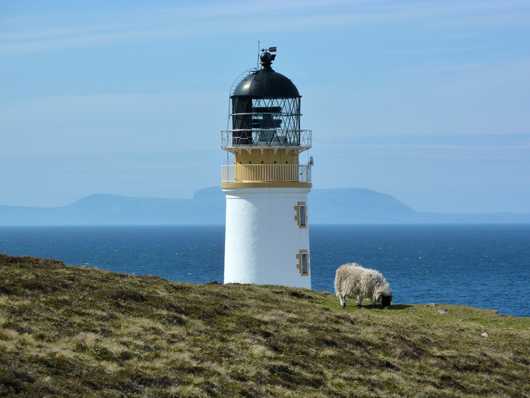Rubh Reidh

Rubh Reidh, Sometimes also referred to as Rua Reidh, Rubha Rèidh or Rubh'Re (pronounced Rue-Ray) is a remote Headland on Scotland's West coast. To the East of the Headland is the entrance to Loch Ewe, to the South are the entrances to the Inner Sound and The Sound of Raasay, seperated by the isle of Rona. To the South-West is the Isle of Skye, and to the West is The Minch, an area of sea between the Western Isles and the Mainland. David Stevenson had proposed a lighthouse on this site in 1853, but the Board of Trade had refused the £5000 cost of construction. David Alan Stevenson went on to reccomended a light be built here in 1906, and initially the construction of a manned station here was opposed by Trinity House (The Lighthouse Service of England and Wales), which did not agree that a lighthouse of this scale was needed on this area of coastline, instead suggesting a smaller automatic light.
Despite the fact that small automated lights had started cropping up around Scotland's shores around a decade prior, the Northern Lighthouse board decided that the headland required a fully-manned station complete with a compressed air fog siren. After a lengthy back-and-forth between the two Lighthouse Authorities Trinity House conceeded to the Comissioners of Northern Lighthouses (Now the NLB) and in 1908 the Board of Trade sanctioned the £14,900 costs for the light and fog signal station.
The Lighthouse was designed by David Alan Stevenson, the Engineer-in-chief to the Northern Lighthouse Board at the time, Entering service on 15th January 1912 the light exhibited 6 quick flashes every 30 seconds, with the siren giving a group of four 2.5 second blasts of the same pitch every 90 seconds during low visibility.
The station consists of a white-painted tower with the standard Northern Lighthouse Board lantern room design, consisting of three rows of flat tessellated triangular panes of glass, and a copper domed roof. On the eastern side of the light tower is a rectangular two-storey block of keepers' houses, and on the western side, facing out towards The Minch was the fog siren, mounted on a smaller tower next to an engine room. The fog signal was discontinued in 1980 and most of the Engine room was demolished in 1985, although the facade and the bottom floor of the siren tower remain in the North Western corner of the site.
Until the 1962 the lighthouse did not have a road connection and due to its remote location had to be reached by sea, which meant that the lighthouse was classed as an Island Station. Keepers and supplies including paraffin for the light were landed at a purpose-built quay a short walk from the lighthouse. Most goods were transported from the quay to the lighthouse via a cart on a track, pulled most of the way by a winding engine at the top of the incline, and then the cart pushed for a short distance to the light station by the keepers.
Two lines of crumbling rusty pipe still run along the length of the short railway track’s route, running under the ground in some places - these were used for bringing fuel to the lighthouse. Parafin would be unloaded by boat at the small quay, into underground holding tanks and one of the pipelines would be used to carry compressed air down from the lighthouse to the fuel tanks, which would would force fuel up the other pipe to the lighthouse where it would be stored in tanks.
In 1986 the lighthouse was converted to electricity with a set of sealed beam units replacing the large 6 panel Fresnel lens. The lens was removed and permanently loaned to the Gairloch Museum along with a large collection of other historic lighthouse equipment, including various parts of the fog signal's apparatus and the large red trumpet that sat atop the fog signal tower.
In 2019 the Gairloch Museum was rehoused into an old Anti Aircraft operations planning bunker just down the road from the original museum building - here the lens is displayed in a larger space, and the metal parts of the lens frame have been repainted into the original brunswick green colour in which they would have been delivered. Opening times for the museum can be found on their website.
